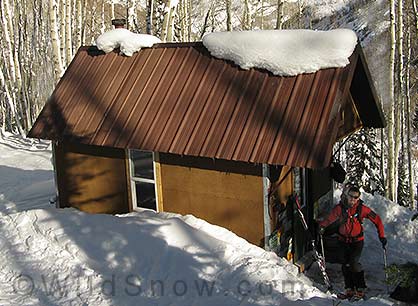Loyal readers, sorry about the delay with covering our do-it-yourself hut RV on wheels. What caused the glitch is we had a couple of options for location. Our first and second choices were land near Marble, Colorado. We also have some friends who told us we could keep our trailer on their land as well, but their property was some distance from home. The purchase deal for first-choice got delayed but continued to look likely, and thus caused us to keep our other choices on hold. To keep all our property dealings as simple as possible, it seemed better to back off on writing about this project. So we got the roof on it, but didn’t complete the interior till recently. We closed on a land purchase this fall, so with that out of the way it’s appropriate to get going with our family portahut again.
More, the land parcel we ended up with is pretty cool as your basic undeveloped Colorado backcountry inholding, lacking in some recreational amenities and a bit “busy” due to summer tourist traffic and nearby mining, but excellent for hiking and of course backcountry skiing access. I’ll cover the land and associated issues more later, but for now, let’s concentrate on how we home-built a temporary wheeled and portable shelter for use in such situations.
First, the whole idea with this sort of thing is the need for a temporary shelter in situations where you have use of backcountry land, but no need or desire to go through the process of building a permanent structure attached to the ground. What’s important in terms of what most land use regulations want is that you don’t live in the unit, and that it is indeed truly portable, not attached to the ground. Essentially, you’re creating a situation where you are camping on the land with something no different than a conventional RV camp trailer, with more comfort than setting up a tent.
Typically these days, folks in this and nearby counties are doing the “temporary structure” thing with yurt tents, on large wooden platforms set on posts. We considered a yurt, but the cons of a yurt don’t appeal to us:
– Quite expensive once you create the platform and buy a yurt that’s large and can handle snowload.
– Still difficult to deal with snow load on roof and against walls.
– Rodent proofing is difficult.
– Curved walls look cool, but result in dead spaces behind beds and such.
– Good windows and insulation require effort.
– Not portable once installed on a large, solid wood platform, for winter use, compared to an RV trailer type rig. Yurt is even difficult to move around property, our trailer can be easily moved.
– “Tent like” feel unless you put work into interior finish.
– Uncertainty about building departments dealing with proliferation of “temporary” yurts that are basically rooted to the same spot for years.
The portahut concept is much different than a yurt. Super solid. Insulate a thick as you want. On wheels so you can have it moving in hours, or even minutes. Even as a temporary structure during home or cabin building, portahut is awesome because you can roll it around your property as you do site work. Later, it can become a storage shed or camper for guest bunking. Or just sell it to the next guy down the line. Main thing is it’s temporary and 100% portable — you’re just parking a camp trailer.
Downsides are of course the building process, and that constructing a trailer is expensive as it needs to be solid if you’ll be moving it even short distances.
I’ve erected one large yurt and stayed in many. Erecting a yurt, while still a bit involved, is something a non-carpenter could do in a day or two (excluding interior furnishing, and things like additional windows and doors). On the other hand, essentially making an RV from scratch requires chops in the carpentry department, not to mention electrical work, propane plumbing, and other things depending on how much you want to do in the way of mechanical systems.
Of course, you could simply buy a cheap used RV travel trailer and stick it on some property (done all the time, all over the country), but in snow climates such as high altitude Colorado, you’d have to rebuild the RV roof anyway for snow load, and the interior would not have that “cabin” feel you can get with how you optionally finish and furnish a yurt or home-built RV. (And don’t even think about building a post supported snow roof over the trailer, as that’s the first thing the building department asked me if I was doing, and related they’d decided that was ‘permanent’ and folks doing so needed a building permit.)
More, you can base your portahut design on how much it’ll be moved. In our case, I designed for the occasional and local move, not for pulling the thing around the country like a commercial RV. But you see “shepherd” trailers all the time that are small portahuts and could roll from here to Alaska and back if necessary. So building to that standard can be done as well. The fun for the do-it-yourselfer is you can take this to any level you want — you could even build your own luxury RV — or just do a plywood box like those hunters you see showing up here every fall with their funky trailer rigs.
For our index of portahut RV posts, click here.
WildSnow.com publisher emeritus and founder Lou (Louis Dawson) has a 50+ years career in climbing, backcountry skiing and ski mountaineering. He was the first person in history to ski down all 54 Colorado 14,000-foot peaks, has authored numerous books about about backcountry skiing, and has skied from the summit of Denali in Alaska, North America’s highest mountain.


